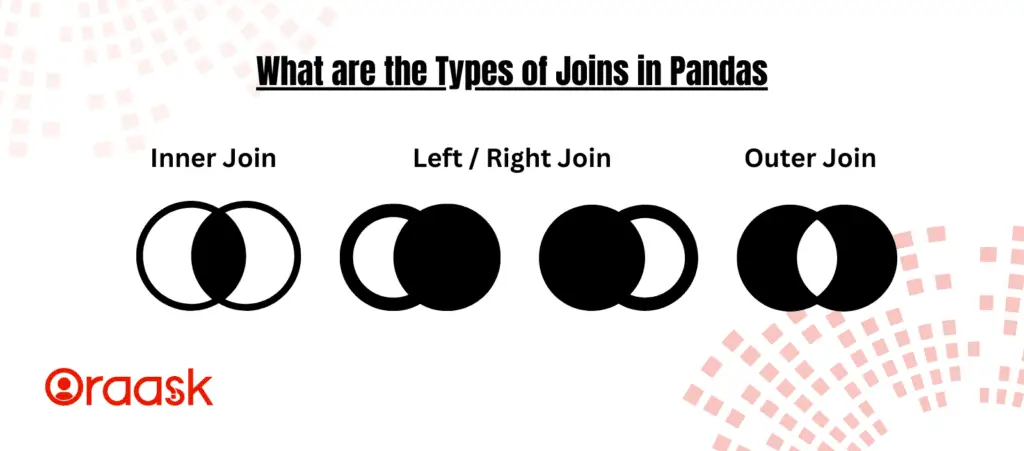How Can We Help?
Introduction
The topic of Python Pandas join is crucial for data manipulation and analysis. It is a process of combining multiple datasets to create a single, comprehensive view of the data. Joining is a joint operation in data analysis, where various tables with different columns or different information are combined to create a single data set.
This blog will explore joining data in Pandas and the different methods available for joining in the Pandas library.
Understanding the Concept of Joining Data in Pandas:
Joining data in Pandas combines two or more datasets into one. The purpose of joining data is to create a comprehensive view of the data. In Pandas, the join operation is performed between two data structures: DataFrame and Series. The resulting data structure will have columns from both the input data structures based on a standard column or index.
Pandas have different join operations, including inner Join, outer Join, left join, and right Join. Every join operation has rules for combining the data and creating the output data structure. The inner join operation combines the rows from input data structures based on a standard column or index. In contrast, the outer Join combines the rows from both the input data structures, including any rows that do not match the other data structure. The left Join combines the rows from the left data structure with the matching rows from the proper data structure, and the right Join combines the rows from the appropriate data structure with the matching rows from the left data structure.

Using the Pandas ‘DataFrame.join()’ Method with inner Join
The ‘DataFrame.join()’ method is one of the most common ways to perform a join operation in Pandas. The technique lets you join two data frames along a specified column or index. By determining the ‘how’ parameter, the ‘join’ method supports all the different join types, including inner Join, outer Join, left join, and right Join.
Example (1)
import pandas as pd
# Create two sample data frames
df1 = pd.DataFrame({'key': ['A', 'B', 'C', 'D'],
'value': [1, 2, 3, 4]})
df2 = pd.DataFrame({'key': ['B', 'D', 'E', 'F'],
'value': [5, 6, 7, 8]})
# Perform inner Join using the DataFrame.join() method
result = df1.join(df2, on='key', how='inner')
# Output the resulting data frame
print(result)Output:
| idx | key | value_x | value_y |
|---|---|---|---|
| 1 | B | 2 | 5 |
| 3 | D | 4 | 6 |
Explanation:
- The code demonstrates performing an inner join operation in Pandas using the ‘DataFrame.join()’ method.
- Import the Pandas library using ‘import pandas as pd’.
- Create two sample data frames, ‘df1’ and ‘df2’, with the ‘pd.DataFrame()’ constructor. Each data frame has a ‘key’ column and a ‘value’ column.
- Perform an inner join operation using the ‘DataFrame.join()’ method. The method inputs two data frames, ‘df1’ and ‘df2’, and performs an inner join on the ‘key’ column. The on parameter specifies the column to join ‘on,’ and the ‘how’ parameter sets the Join to perform (‘how’=’inner’). The result is stored in a new data frame called ‘result.’
- Finally, the ‘print()’ function outputs the resulting data frame ‘result.’ The output shows only the rows with matching keys in both data frames. In this case, the keys ‘B’ and ‘D’ are present in both data frames and appear in the result, while the keys ‘A,’ ‘C,’ ‘E,’ and ‘F’ are not included in the result.
Using the Pandas ‘DataFrame.join()’ method with outer Join.
Outer Join is a join operation in Pandas where all the rows from both data frames, including the non-matching keys, are returned. You can perform an outer join by specifying the ‘how’ parameter as ‘outer’ in the ‘DataFrame.join()’ method. This join returns all the records in both data frames, with missing values represented as NaN for the non-matching keys.
Example (2)
import pandas as pd
# Create two sample data frames
df1 = pd.DataFrame({'key': ['A', 'B', 'C', 'D'],
'value': [1, 2, 3, 4]})
df2 = pd.DataFrame({'key': ['B', 'D', 'E', 'F'],
'value': [5, 6, 7, 8]})
# Perform outer Join using the DataFrame.join() method
result = df1.join(df2, on='key', how='outer')
# Output the resulting data frame
print(result)Output:
| idx | key | value_x | value_y |
|---|---|---|---|
| 0 | A | 1.0 | NaN |
| 1 | B | 2.0 | 5.0 |
| 2 | C | 3.0 | NaN |
| 3 | D | 4.0 | 6.0 |
| 4 | E | NaN | 7.0 |
| 5 | F | NaN | 8.0 |
Explanation:
- First, we have imported the pandas library in the code.
- Next, we created two sample data frames, df1 and df2. We created the data frames using the pandas DataFrame function, which takes a dictionary as its argument. In this case, both data frames have two columns: ‘key’ and ‘value’.
- Next, we performed an outer join of the two data frames using the join() method of the df1 data frame. The join() method takes two arguments: df2 (the data frame to be joined with df1) and on (the column to join on). The how argument is set to ‘outer’, meaning that all the rows from df1 and df2 will be included in the result, with missing values filled with NaN.
- The result of the code will be a new data frame containing all the rows from df1 and df2, with missing values filled with NaN for rows in either data frame that does not match the other.
Using the Pandas ‘DataFrame.join()’ method with left join
It is a join operation in Pandas where all the rows from the left data frame (‘df1’ in this case) are returned, including the non-matching keys from the proper data frame (‘df2’ in this case). You can perform a left join by specifying the ‘how’ parameter as ‘left’ in the ‘DataFrame.join()’ method. This type of join returns all the records in the left dataframe and only the matching records in the right dataframe, with missing values represented as NaN for the non-matching keys in the right dataframe.
Example (3)
import pandas as pd
# Create two sample dataframes
df1 = pd.DataFrame({'key': ['A', 'B', 'C', 'D'],
'value': [1, 2, 3, 4]})
df2 = pd.DataFrame({'key': ['B', 'D', 'E', 'F'],
'value': [5, 6, 7, 8]})
# Perform left join using the DataFrame.join() method
result = df1.join(df2, on='key', how='left')
# Output the resulting dataframe
print(result)Output:
| idx | key | value_x | value_y |
|---|---|---|---|
| 0 | A | 1.0 | NaN |
| 1 | B | 2.0 | 5.0 |
| 2 | C | 3.0 | NaN |
| 3 | D | 4.0 | 6.0 |
Explanation:
- First, we imported the Pandas library into the code.
- Create two sample data frames, df1, and df2. We created the dataframes using the pandas DataFrame function, which takes a dictionary as its argument. In this case, both data frames have two columns: ‘key’ and ‘value’.
- We performed a left join of the two data frames using the join() method of the df1 data frame. The join() method takes two arguments: df2 (the data frame to be joined with df1) and on (the column to join on). The how argument is set to ‘left’, which means that all the rows from df1 will be included in the result, with missing values in df2 filled with NaN.
- The result of the code will be a new data frame that contains all the rows from df1 and the matching rows from df2 (if they exist). If a row in df1 does not have a matching row in df2, the corresponding values in df2 will be filled with NaN.
Final Thoughts
In conclusion, joining data in Pandas is an essential operation that enables us to combine and analyze data from multiple sources. The DataFrame.join() method provides an efficient and flexible way to perform various join operations in Pandas, including inner, outer, and left join. Understanding the concept of joining data and the syntax of the DataFrame.join() method is crucial for any data analyst or scientist working with Pandas. With the skills acquired from this article, you can join operations quickly and confidently and make the most out of your data.




